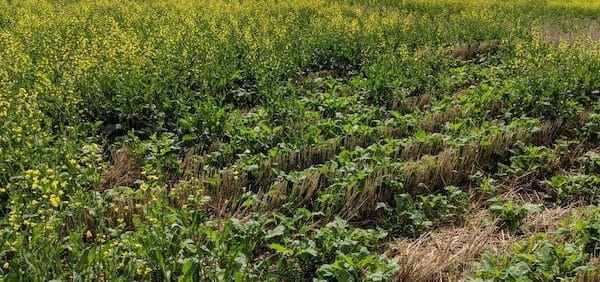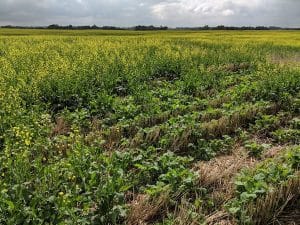Growers wonder how to approach harvest when canola fields have plants and patches at quite different stages of maturity. With any approach, the least mature areas of the field need to be left to mature. Swathing remains the best and least risky option to manage extreme variation in maturity.
When do I swath? As for timing, the goal is 60% seed colour change on the main stem, but wait until the least mature areas have a degree of colour change on the bottom pods and seeds in the outer branches are no longer mushy and translucent. Varieties with a degree of shatter tolerance can make it easier to delay swathing, letting the least mature areas catch up as much as possible. Keep in mind that more mature canola can be fluffier and more difficult to anchor in the swath, making it more prone to blowing and damage in the swath.
If farmers don’t want to swath, the question then is whether to let the uneven canola crop ripen naturally or whether to spray a pre-harvest product.
With enough time, leaving a pod-shatter tolerant variety to dry-down naturally can be a suitable (and lower cost) option to swathing and pre-harvest spraying. Preliminary results from a project assessing pre-harvest aids in canola suggests these products are less necessary under warm and dry conditions in the late summer/early fall.
Do I apply a pre-harvest aid to dry down the green patches? This is not an ideal situation for any of the pre-harvest products available for use on canola. Each has its downsides when it comes to uneven crop.
–Diquat (Reglone Ion) stops maturity, so anything too green when the sprayed will stay green. The risk with an uneven crop is that chlorophyll levels will be locked in, which is why Diquat should not be used on crops with extreme variation in maturity. Diquat application timing is 90% brown seeds. At this stage, all but 10% of the seeds on the very top and outer most branches haven’t completely turned black or brown. This is very different from a seed colour change (SCC) measurement that only refers to the main stem and includes any seeds with a degree of speckling or mottling.
Syngenta provides the following tips on how to stage the crop:
–Survey the field. Look for brown colouring in the upper pods and stems. You should not see any yellow or green.
–Listen for a rattle in your pods. Mature seeds are loose in the pod and rattle when the plant is shaken.
–Look for brown seeds. Strip out seeds from several areas of the field. The crop is ready when 90% of each plant has seeds that have turned completely brown.
Syngenta supports the use of Reglone Ion on shatter-tolerant canola only.
–Saflufenacil (Heat) has a labelled application rate of 60-75% brown seed, although most recent BASF literature recommends 80% brown seed. Talk to your rep about the application timing they support. With a slightly earlier application timing and both contact and systemic activity, this product is better suited than diquat to manage some variation in maturity.
–Glyphosate has the earliest application timing of all the products (labelled at when seed from the least-mature plants have less than 30% moisture). Having an earlier application window and strictly systemic, slow-acting mode of action, this product is the best option of the pre-harvest products when dealing with variable maturity in non-glyphosate tolerant canola. Even so, swathing still remains the ideal choice for managing extreme variance in maturity. Remember to Keep It Clean. It is critical to wait until seed moisture content is less than 30% in the least-mature areas of the crop before applying glyphosate. Applications made before the correct stage increase the risk of unacceptable residue in the seed. By waiting until 50 to 60% seed colour change in the least-mature areas of the field, growers can be confident seed moisture will be at less than 30%. Learn more and see a visual example of a canola plant ready for fall glyphosate application at keepingitclean.ca/glyphosate.
How can hot, dry conditions change the scenario? Rapid crop advancement due to hot, dry conditions can mean the driest pods become brittle in less time – which is especially risky for plants without pod-shatter tolerance. Hot, dry conditions could reduce the ability for late seeds to fill out before shriveling up. What we do know is that swathing early is probably the wrong move, especially if the later areas are also those with more yield potential. Plants in lower areas could also be rooted into moisture at depth, which means seeds could still be filling despite dry conditions.
Further reading:
- Important Timing Message for Pre-harvest Glyphosate
- Visit Keep it Clean for ways to keep your crops ready for market.
- PAMI comparison of pre-harvest aids

